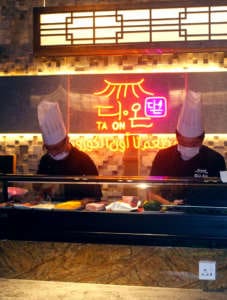Hi, and welcome to Taon new blog today we will share with you the great Korean food that we have on our menu you would like to try it after knowing all the amazing information about it. Let’s get started.


As you know our restaurant has Asian Food, Korean Food menu such as the Korean Traditional Food Japanese famous seafood and we set it up on the menu as a Japanese Lunch Set and Japanese Lunch Set B let’s know more about this food:
Korean Lunch Set: Beef Bulgogi / Rice/ Soft Tofu soup:
Beef Bulgogi:
It is a Korean-style grilled or roasted meal, also known as “fire meat” is constructed of thin, marinated slices of meat, usually beef, that are barbecued on a grill or griddle over heat. In home cooking, it is also frequently stir-fried in a skillet. The recipe often uses cuts of beef including sirloin, rib eye, or brisket. Although the meal originated in the north of the Korean Peninsula, it is very well-liked in South Korea, where it can be found at premium eateries as well as neighborhood groceries as pan-ready kits.
Korean Bean Paste Soup:
Soft Tofu Soup or Bean Paste Soup, in Korean cooking they call it jjigae and it is mean soup. Freshly curdled soft tofu that hasn’t been pressed or strained, vegetables, occasionally mushrooms, onion, optional shellfish (often oysters, mussels, clams, and shrimp), optional meat (typically beef or pork), and gochujang or red pepper powder are all used to make this dish. The serving dish, which is typically constructed of thick, sturdy porcelain but can sometimes be crushed out of solid stone, is where the dish is assembled and baked. Just before serving, a raw egg can be added to the jjigae, and the dish is given while bubbling ferociously. Usually, it is consumed with a bowl of cooked white rice and a number of banchan. Extra soft tofu is softer than other varieties of tofu and is known as sundubu (mild tofu) in Korean. typically offered in tubes. In Korean, the word sundubu is translated as “pure”. you can have this Korean food in Abu Dhabi now in Taon Korean restaurant cooked by Korean chief with more than 10 years cook experience.
The Japanese Lunch set is:
Sushi 6 pcs / Roll & Maki 4 pcs / Tempura 3 pcs / Miso Soup / Green Salad.




Japanese Sushi:
is a traditional Japanese cuisine that consists of prepared vinegared rice (sushi-meshi), typically with some sugar and salt, and a variety of items (neta), including vegetables and seafood that is frequently fresh. Sushi rice, also known as shari or sumeshi, is a crucial component of all sushi styles and presentations. Although brown rice or short-grain rice can also be used to produce sushi, medium-grain white rice is the typical ingredient. It is frequently made with seafood, including imitation crab meat, squid, eel, yellowtail, salmon, and tuna. Sushi comes in many vegetarian varieties. Wasabi, soy sauce, and pickled ginger (gari) are frequently added to the dish. Popular toppings for the dish include pickled daikon (takuan) or daikon radish.
Roll & Maki:
is a Japanese food they call it [makizushi] in Japan are typically what people who are not Japanese picture when they think of sushi. Fillings are wrapped in rice and nori seaweed to make makizushi. You can make a basic makizushi roll using the instructions in this recipe and then fill it with any filling you like. Learn the method and use your imagination.
a cylindrical item made with the use of a bamboo mat called a makisu and is used generally for other foods as well) or makimono (variety of rolls). Makizushi is typically wrapped in nori (seaweed), although it can also occasionally be in soy paper, cucumber, shiso (perilla) leaves, or a thin omelette. A single roll order of makizushi typically consists of six or eight pieces. Most often, short-grain white rice is used, however short-grain brown rice can also
The popularity of rice is growing among health-conscious people, much like the popularity of olive oil on nori. Makizushi rice occasionally contains sweet rice.
Tempura:
is a traditional Japanese cuisine that often consists of battered and deep-fried fish, pork, and veggies. Using fritter-cooking methods, the Portuguese brought the dish to Nagasaki in the sixteenth century. The word “tempura” is derived from the Latin word “tempora,” which was used to describe periods of fasting during which Catholics were required to abstain from meat.
Miso Soup:
consists of softened miso paste combined into dashi stock to create this traditional Japanese soup. There are other additional optional ingredients (various vegetables, tofu, abura-age). Things could be included based on regional and seasonal cuisines, as well as individual taste. Miso soup is an example of a soup dish served with rice in Japanese cuisine. Omiotsuke is another name for miso soup. Miso soup is regarded as one of the two fundamental varieties of soup in Japanese cuisine, along with suimono (clear soup in a dashi stock that is seasoned with a tiny quantity of soy sauce and salt).


